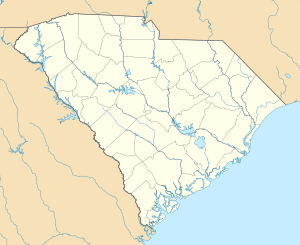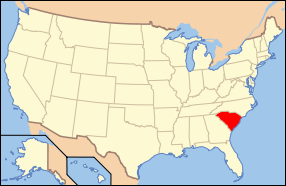Lowndes Grove
|
Lowndes Grove | |
|
Lowndes Grove in 1940 | |
  | |
| Location | 260 St. Margaret St., Charleston, South Carolina |
|---|---|
| Coordinates | 32°48′6″N 79°57′58″W / 32.80167°N 79.96611°WCoordinates: 32°48′6″N 79°57′58″W / 32.80167°N 79.96611°W |
| Built | 1786 |
| Architectural style | Georgian |
| NRHP Reference # | 78002500[1] |
| Added to NRHP | 30 August 1978 |
The Lowndes Grove, also known as The Grove[2] or Grove Farm, is a plantation house built in about 1786 on the Ashley River in Charleston.[3] It is located on a triangular plot of land bordered by St. Margaret Street, 5th Avenue, and 6th Avenue.[4] It was named to the National Register of Historic Places on 30 August 1978.[1][3][5][6]
History
John Gibbes built a house and garden with greenhouses on The Grove before the Revolutionary War.[2] The house was probably located near Indian Hill on the Citadel campus. It was likely destroyed in 1779,[7] but the gardens remained. Around 1786, heirs of the Gibbes family divided the land into smaller tracts, and three of the northernmost parcels were acquired by George Abbot Hall. Since the 1791 inventory of Hall's estate mentioned a house, it is assumed that the house was built around 1786.[3] The next owners were the Beaufain brothers of the West Indies who operated a small faming operation on the site. They sold the house, which they had named Wedderburn Lodge, to Mary Clodner Vesey. She, in turn, in 1803, sold the property to William Lowndes, who was elected to the U.S. Congress. He served in Congress until he resigned due to poor health in 1822.[3]
After several owners, a Charleston businessman, Frederick W. Wagener, acquired the house. He was the president and one of the chief promoters of the South Carolina Inter-State and West Indian Exposition, which was held in 1901–1902. The exposition was held on his 250 acres (100 ha). The Lowndes Grove house was used as the Woman's Building.[3][8][9]
Architecture
It is a 1 1⁄2-story frame house on a raised basement. The top one and one-half stories are frame construction. The lower story and basement are stucco-covered brick. The house was probably designed in the Georgian style, but its original appearance has been lost during the course of many renovations. It probably had a double portico, modified in about 1830 into a five-bay upper piazza with Doric columns and balustrades. The three center bays project forward and have a pediment and oculus. The piazza and house have entablature with modillion and dentil blocks. In the 1830 renovations, the house was extended toward the rear. The sides of the house have nine over nine lights.[3]
The house has a hip roof that was covered with terra cotta tiles in the 1920s. There are two dormers on each of the sides and three dormers in the rear. The house has two interior chimneys with corbelled caps.[3]
The interior has a four-room plan with central hallway. The ceilings and walls are plastered. The house has its original floors. Most major rooms are decorated in Adamsesque style with cornices, ceiling medallions, and carved mantels. The first and second story rooms on the northwest were decorated in Regency style when the house was enlarged. The first floor room toward the northeast was badly damaged in a fire during the 20th century. The room was rebuilt as a kitchen and library. The house has a spiral staircase with circular skylight.[3] Additional pictures are available.[10][11]
References
- 1 2 National Park Service (2009-03-13). "National Register Information System". National Register of Historic Places. National Park Service.
- 1 2 Leiding, Harriette Kershaw (1921). Historic houses of South Carolina. Philadelphia, Pennsylvania: J.B. Lippincott Company. pp. 188–192.
- 1 2 3 4 5 6 7 8 McNulty, Kappy (10 December 1971). "Lowndes Grove" (PDF). National Register of Historic Places Inventory – Nomination Form. National Park Service. Retrieved 20 May 2009.
- ↑ "+32° 48' 6.00", −79° 57' 58.00". Google Maps. Google. Retrieved 20 May 2009.
- ↑ "Lowndes Grove, Charleston County (260 St. Margaret St., Charleston)". National Register Properties in South Carolina. South Carolina Department of Archives and History. Retrieved 23 May 2009.
- ↑ "Lowndes Grove". South Carolina Plantations. SCI-way.net. Retrieved 22 May 2009.
- ↑ "Gibbes Landing" http://www.halseymap.com/Flash/window.asp?HMID=35
- ↑ Chibbaro, Anthony (2001). The Charleston Exposition. Mount Pleasant, South Carolina: Arcadia Publishing. p. 47. ISBN 0-7385-0682-6.
- ↑ McLaughlin, J. Michael; Toddman, Lee Davis (2003). It Happened in South Carolina. Guilford, Connecticut: Globe Pequot Press. pp. 106–107. ISBN 0-7627-2452-8.
- ↑ "Lowndes Grove (House), Saint Margaret Street & Sixth Avenue, Charleston, Charleston County, SC(Photographs)". Historic American Building Survey. National Park Service. Retrieved 23 May 2009.
- ↑ Stoney, Samuel Gaillard; Simons, A., and Lapham, Samuel, Jr. (1989). Plantations of the Carolina Low Country (7th ed.). Mineola, New York: Courier Dover Publications. pp. 74, 202. ISBN 0-486-26089-5. Cite uses deprecated parameter
|coauthors=(help)
%2C_Saint_Margaret_Street_%26_Sixth_Avenue%2C_Charleston_(Charleston_County%2C_South_Carolina).jpg)

